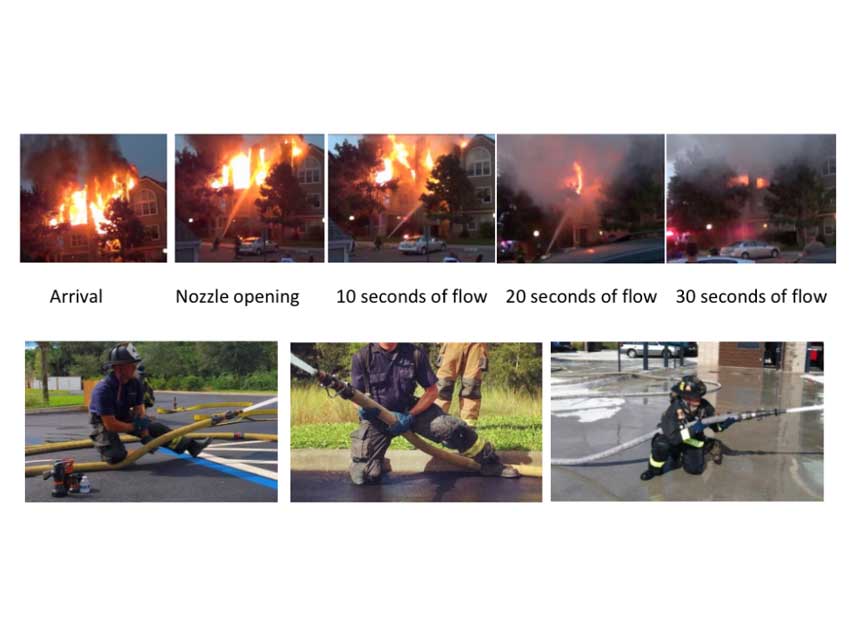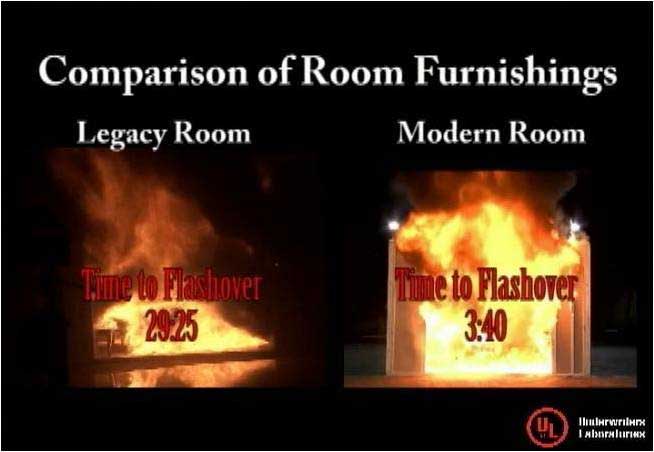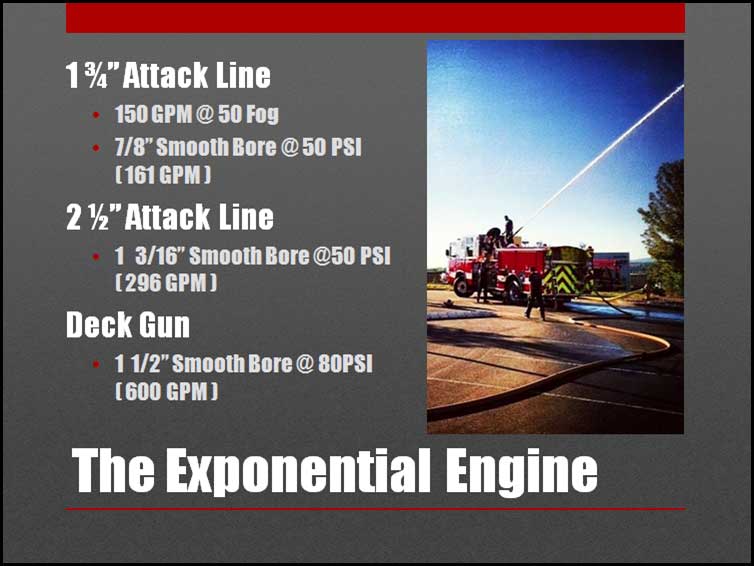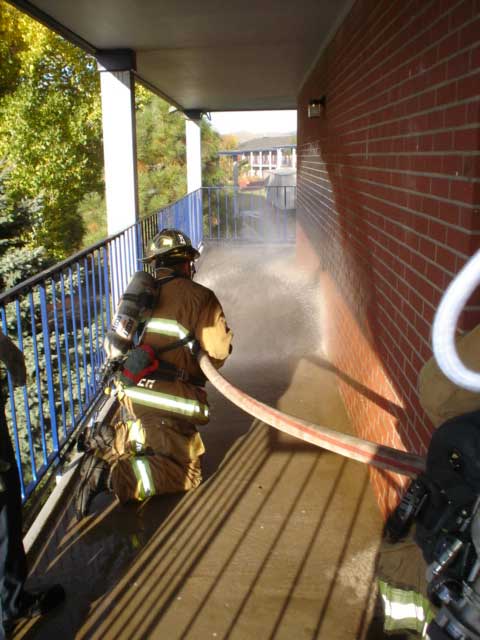
By Brian Brush
There are two questions I field more than any others when it comes to fire streams and apparatus setup. The first is, “How is your engine set up?” and the second, “How would you set up an engine.” I believe most of the time people who ask the first question really want the answer to the second question, so rather than waste the explanation of how an engine is currently set up and what I would change, I will start with a blank sheet and explain one approach to setting up a rig to maximize first-due potential with the exponential engine approach.
RELATED
Brian Brush: Hit-and-Move Fire Attack
Extending from a Trunk Line to a Hose Bundle
Definition
This article addresses the masses and focus on first-arriving engine operations. First, I will explain my observation and, therefore, the context of today’s most common engine company as it pertains to this article:
- Three-person staffing (operator, officer, firefighter)
- Two-person attack line (officer, firefighter)
- Water as the extinguishing agent (no compressed air foam system option)
- 500-gallon on-board tank
- 1¾-inch, 2½-inch, and engine-mounted master stream as initial attack options.
Figure 1. Flashover Times for Legacy and Modern Rooms

Exponential Attack
In various firefighting and fire prevention documents, you will find a statement that states that if given appropriate fuel and air, a fire will double in size every XX seconds or minutes. The times given range from 30 seconds to two minutes. The difference in time between 30 seconds to two minutes has never bothered me too much since I consider both relatively fast. The point that always has stuck with me from that adage is the term “double in size.”
When I consider something doubling in size, I think of exponential growth; and I believe that if we view the fire as an enemy, exponential growth of the enemy’s force is a power curve that must be addressed swiftly and with dominance. I think that most engaged firefighters would agree with that point, but how to attack swiftly and with dominance has many forms when it comes to fire streams.
Some firefighters are pushing for greater volume on all initial lines with the use of intermediate lines and tips like 15/16-inch and one-inch tips on two-inch attack lines. Others are advocating for immediate fire stream application for the exterior if there is an opportunity for an interior follow-up to “reset the fire” and interrupt that exponential growth. Both ideas have merit; these members are attempting to find the right solution for their departments’ addressing the modern fire environment. I would like to present one more way to combat exponential fire growth–with an exponential fire attack plan.
Exponential Fire Attack Plan
The exponential engine idea came to me while I was sitting in a class at FDIC delivered by Chief Curt Isakason from Escambia County (FL) Fire Rescue. Chief Isakson was speaking about the importance of rapid water application, and he instantly shifted my thinking when he began to discuss fire stream flows in terms of gallons per second (gps) vs. gallons per minute (gpm).
Have you ever heard this before? “If you take the XXXX fire formula, it would take only 40 gallons to control a typical bedroom fire. It is overkill to take a 150-gpm fire stream to such a minor fire” This thought process has always frustrated me; but to be honest, I always struggled with articulating a counterpoint until I began to consider the importance of exponential fire growth and gps.
Let us say that a fire doubles in size every 30 seconds. If the current bedroom fire takes 40 gallons to control and it doubles in 30 seconds, then 30 seconds from now, it will require 80 gallons; and at one minute, it will require 160 gallons. A 150-gpm stream is a 2½ gps stream. At 2½ gps, 40 gallons of water is delivered to that bedroom in just 16 seconds of operation. At 30 seconds of operation, 75 gallons of water would be delivered to that room, likely resulting in total room cooling, not just fire control.
Chief Isakson’s message to shift from gpm fire streams to gps fire streams could not be more appropriate. If the statement that a fire doubles in size every 30 seconds is wrong, so be it. You cannot argue that fire behavior in enclosed structures is changing faster than ever before and our windows of opportunity to act, which were once measured in minutes, have been reduced to seconds.
So, if we are dealing with exponential fire growth, limited staffing, and rapidly changing fire conditions, the entire fire service—not just a few inspired firefighters–should be evaluating their fire stream systems from the source to the nozzle because we need to find ways to leverage our efforts at every point.
Figure 2. The Exponential Engine

To provide a very brief overview before I expand on the idea, every engine company should be designed with a first-due “Plan A” to attack whatever you have with all you have. Setting up a rig with a plan for extended operations or waiting for the cavalry to arrive before you act only puts you closer to engaging a different fire than the one you are seeing (catch up). Variables will forever exist, and nothing is set in stone; but, as firefighters, we plan for a fight.
1¾-Inch Line
One of the biggest pushes out there is greater volume from initial lines. Many fire departments are choosing 15/16-inch smooth bores or 185-gpm fogs. Some are even experimenting with two-inch hose and one-inch tips for the foundation of their fire attacks. If training, district construction, and staffing make these viable options, great: You are taking big weapons to the fight early on.
In my experience, the initial handline for residential fires (a room or rooms on fire) for most fire departments is the 1¾-inch.” The benefits of the 1¾-inch attack line is that it supports a good fire flow for these size fires and it is very maneuverable for working on the interior of smaller compartmentalized occupancies. I think it is important to play up these strengths of the 1¾-inch and be cautious of the diminishing returns that the three-person engine company encounters when too much is asked of this line. If our minimum interior attack fire flow is 150 gpm, then the key operational range for the 1¾-inch attack line is between 150 and 185 gpm. Working above this range in volume starts to creep into high-friction loss ranges and nozzle reaction forces, especially if nozzles are used with operating pressures greater than 50 pounds per square inch (psi).

(1)
What is key to remember is that nozzle ratings are just “ratings”: When closed, all nozzles flow 0 gpm. A 150-gpm or 2½-gps nozzle may seem “inferior” to one that flows 185 gpm or three gps, but if the nozzle firefighter can comfortably flow that nozzle for 30 seconds at a time around a corner while actively playing it, you are delivering 75 gallons to the fire environment. A nozzle firefighter struggling with a 185-gpm or 200-gpm nozzle can operate only for 10 to 15 seconds at a time without fatiguing and has poor stream movement is potentially ineffectively applying only 30 to 50 gallons at a time to the fire environment.
RELATED
FRICTION LOSS FOR 1 3/4-INCH HOSE
Systematic Views of the 2 1/2-Inch Handline in Fire Attack
Bringing the Medium-Diameter Line Back into the Mainstream
I think the foundational line of the exponential engine company should be the 1¾-inch line so it can be rapidly deployed and easily maneuvered into position in the fire building with a nozzle flowing 2½ gps from a 150-gpm at 50-psi fog or 7/8-inch smooth bore with a nozzle reaction of 60 or less pounds of force.
2½-Inch Line
“I will not dispute that 21/2-inch hose is difficult to use, but no combination of smaller handlines can duplicate the volume, reach, and pure knockdown power of a single, well-placed 2½-inch line.” Andy Fredericks
At this point, I don’t see the need to review ADULTS or get really detailed about when we should pull the 2½-inch. If you are still reading this article, you can recognize a fire that demands the 2½-inch line. The struggle seems to come when the discussion shifts from “when” to “how,” especially with the three-person engine. The most common concerns are that it is such a bigger and heavier line; in these concerns are the keys to its use, but we need to have more realistic expectations.
The 2½-inch attack line is not a 1¾-inch; accept that and move on. The 1¾-inch is the lightweight fighter; it can skip around the ring quickly for all 12 rounds and with great agility. The 2½-inch is the heavyweight fighter; it will move more slowly, but with purpose. There can’t be wasted energy, and it is hoping for an early knockout so it doesn’t have to go the distance. In short, the 2½-inch can be used very effectively with limited staffing; it will just be a little slower and not nearly as long of an engagement, but the punch it delivers is a big enough benefit that it is worth it. Attack whatever you have with what you have, and understand the purpose of gallons per second.

(2-6)
In the above series of photos, a single firefighter is putting a 2½-inch attack line in service on a working fire while his officer sets up the line for advancement after the knockdown. The nozzle is a 1-1/8-inch smooth bore, and the line was operated for about 30 seconds from the parking lot before it was shut down and advanced into the stairwell for follow-up. In that 30 seconds, 132 gallons were delivered, and it made a significant difference on that fire. Although a second alarm was instantly called for on arrival, the quick action and rapid delivery of water prevented the fire from growing to the point where those resources were needed.
While working with another firefighter recently, we reviewed this video, and his comment was, “That is a great example of using what you have. Too often, we drive around in fire engines and act is if we don’t have tanks of water.” His point, my point, and Chief Isakson’s point is that if you view the 2½-inch as a 250-gpm line, your thinking will inherently fall to flowing for minutes, and you will talk yourself out of using it because you believe you do not have the ability to support it. If you look above at the effect that 132 gallons delivered over 30 seconds had on that fire and you imagine your 500-gallon tank allowing for that kind of knockdown to be followed up almost three more times, you should see that you are not giving yourself nearly enough credit for your capabilities, and you are just sitting on your opportunity to make a difference.
The above attack used a 1-1/8-inch smooth bore, which flows 265 gpm or 4.4 gps, which is impressive; but the idea of an exponential engine is exponential increases, and we started with a150- and a 161-gpm line so the goal would be to put at least a 300-gpm 2½-inch into service as our next option, delivering five gps.
To place a 300-gpm attack line in service, nozzle selection is very limited. A 100-psi fog nozzle delivering 300 gpm would have a nozzle reaction of 150 pounds force and would be extremely difficult for any firefighter to use in anything other than a fully defensive position. At 50 psi, the 1-3/16-inch smooth bore delivers 296 gpm or 4.9 gps with 111 pounds of nozzle reaction, and the 1¼-inch smooth bore delivers 328 gpm or 5.5 gps with 123 pounds of nozzle reaction.
I would feel comfortable with either of these tip choices as a weapon, just as I would with the 150 gpm at 50 psi fog or the 7/8-inch smooth bore on the 1¾-inch attack line. There is one thing I found particularly interesting about the 1-3/16-inch tip when you apply our true 2½-inch friction loss coefficient compared to the 1-1/8-inch tip with the traditional IFSTA based coefficient:
- Friction loss per 100 feet of 2½-inch hose flowing 265 gpm from a 1-1/8-inch smooth bore tip using the IFSTA coefficient of 2 is 14 psi.
- Friction loss per 100 feet of 2½-inch hose flowing 296 gpm from a 1-3/16-inch smooth bore tip using a modern true hose internal diameter coefficient of 1.4 is 12 psi.
Technically, if you are using IFSTA-based coefficients and modern 2½-inch hose, you could just replace all the 1-1/8-inch tips on your attack lines with a 1-3/16-inch, and you would be flowing more than 300 gpm or 5 gallons gps from your lines without anyone even knowing. Furthermore, the very low operating pressure may present the opportunity to eliminate a step for your pump operator.
It requires a pump discharge pressure of only 68 psi to flow a 150-foot attack line with an 1-3/16-inch tip flowing right at 5 gps. I have seen this operating pressure to be nearly idle for many modern fire pumps. Imagine if you set up a preconnected 5-gps attack line to the point that it could be supported at idle. The speed at which big water could be applied if all your pump operator would have to do when he got out of the cab was to pull the tank to pump and discharge, eliminating the need to throttle up.
I know we clearly outlined working limits for nozzle reaction and the fact that this plan is intended for the three-person engine company, but, if you remember, the challenges of a bigger heavier line are also the keys to its use.
When you are advancing or dragging a line, friction is your enemy because you want the line to move forward into position with as little resistance and work as possible. When you are flowing a line, friction becomes your friend because you can use it to absorb and counter nozzle reaction. The bigger and heavier a line, the more friction is present, and well-trained operators can capitalize on that friction to serve as a backup person in absorbing and grounding nozzle reaction. Additionally, the larger-diameter hose creates a more solid pipe and allows for more line to be moved ahead of the body, resulting in greater stream movement without exaggerated body movement.

(7-9)
In all these photos, the single operator is flowing between 265 and 300 gpm using line weight, the ground, a curb, a wall, or good body form to handle the higher nozzle reaction. As stated above, this makes it a much less mobile line when compared to the 1¾-inch, and it will most likely be operated only in a hit-and-move process; but what is compromised in mobility is made up for in stream reach, punch, and an extinguishing power that has been doubled without any staffing changes.

(10)
The Deck Gun
The deck gun might be a regional term. I have also heard it called the “monitor” or the “Stang,” but we are talking about the engine-mounted master stream. Most engine-mounted master streams fog or a stack of smooth bore tips has a flow range of 500 to 1,000 gpm.
If we review our progression, the 1¾-inch flowing 2½ gps is a rapidly deployed and highly mobile attack line for a room or rooms of fire. The 2½-inch attack line flowing five gps is our heavyweight fighter looking for the big knockdown against the big opponent of a full residential floor on fire, commercial occupancy fire, or any of the ADULTS situations. Finally, we have the deck gun for those marginal situations where you arrive to find an entire building on fire and rapid application of your entire tank at 10 gps is required to nuke the fire’s progress and prevent extension to exposure occupancies. ⅜
When you double 2½ gps, you get five gps, which, when doubled, is 10 gps; so, our target rating for a deck gun would be 600 gpm. The point of picking 600 gpm as the target flow for the deck gun goes beyond just the goal to double the volume of our previous attack level. Engine-mounted master streams outfitted with a series of stacked smooth bore tips are most commonly found with a 1⅜-inch, 1½-inch, 1¾-inch, and a 2-inch tip.
Smooth Bore Tip Sizes and Stream Volume at 80 psi
1⅜-inch 500 gpm
1½-inch 600 gpm
1¾-inch 800 gpm
2-inch 1,000 gpm
When a smooth bore of these diameters is used as master streams, the operating pressure is 80 psi; and because the apparatus is the platform of operation, nozzle reaction need not be considered. Most of the times, I check engines with these stacked tips and find that the full stack is in place with the 1⅜-inch on top. Two reasons for this are they came that way or the engine has a 500-gallon tank and using a 500-gpm tip would give nearly a minute of operation before a supply is needed.
Throw Back to Basics: Deck Gun Operations
Once again, this is thinking in minutes and trying to make what you have last over making what you have matter. I recommend the 1½-inch tip as the first up on the deck gun. Having tried this on a variety of engines, I found this 10-gps stream to be the highest volume, best quality stream that can be delivered strictly from tank supply. As you begin to move to the 1¾-inch and 2-inch tips, a lot is being asked of the unsupported pump and internal plumbing, and the larger tip size reduces the stream reach and pinpoint accuracy you find in the 1½-inch tip.
There are hundreds of options and combinations for fire attack at the disposal of today’s firefighters. I have found that the three-person engine can perform only one action at a time and this is one way to simplify and maximize the effectiveness of these first-due actions.
BIO
BRIAN BRUSH, an 18-year veteran of the fire service, is a firefighter at Edmond (OK) Fire Rescue. He has a bachelor’s degree in fire and emergency services administration and Fire Officer designation from the Center for Public Service Excellence. He instructs for FDIC and writes for Fire Engineering.
Originally ran August 21, 2017.

